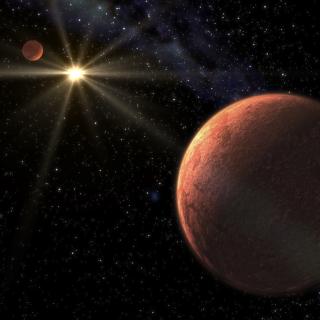Bibcode
Lacedelli, G.; Pallé, E.; Luque, R.; Cadieux, C.; Murphy, J. M. Akana; Murgas, F.; Zapatero Osorio, M. R.; Tabernero, H. M.; Collins, K. A.; Watkins, C. N.; L'Heureux, A.; Doyon, R.; Jankowski, D.; Nowak, G.; Artigau, É.; Batalha, N. M.; Bean, J. L.; Bouchy, F.; Brady, M.; Canto Martins, B. L.; Carleo, I.; Cointepas, M.; Conti, D. M.; Cook, N. J.; Crossfield, I. J. M.; González Hernández, J. I.; Lewin, P.; Nari, N.; Nielsen, L. D.; Orell-Miquel, J.; Parc, L.; Schwarz, R. P.; Srdoc, G.; Van Eylen, V.
Referencia bibliográfica
Astronomy and Astrophysics
Fecha de publicación:
12
2024
Revista
Número de citas
2
Número de citas referidas
1
Descripción
Context. The exoplanet sub-Neptune population currently poses a conundrum, as to whether small-size planets are volatile-rich cores without an atmosphere, or rocky cores surrounded by a H-He envelope. To test the different hypotheses from an observational point of view, a large sample of small-size planets with precise mass and radius measurements is the first necessary step. On top of that, much more information will likely be needed, including atmospheric characterisation and a demographic perspective on their bulk properties. Aims. We present here the concept and strategy of the THIRSTEE project, which aims to shed light on the composition of the sub-Neptune population across stellar types by increasing their number and improving the accuracy of bulk density measurements, as well as investigating their atmospheres and performing statistical, demographic analysis. We report the first results of the program, characterising a new two-planet system around the M-dwarf TOI-406. Methods. We analysed TESS and ground-based photometry together with high-precision ESPRESSO and NIRPS/HARPS radial velocities to derive the orbital parameters and investigate the internal composition of the two planets orbiting TOI-406. Results. TOI-406 hosts two planets with radii and masses of Rc = 1.32 ± 0.12 R⊕, Mc = 2.08‑0.22+0.23 M⊕ and Rb = 2.08‑0.15+0.16 R⊕, Mb = 6.57‑0.90+1.00 M⊕, orbiting with periods of 3.3 and 13.2 days, respectively. The inner planet is consistent with an Earth-like composition, while the external one is compatible with multiple internal composition models, including volatile-rich planets without H/He atmospheres. The two planets are located in two distinct regions in the mass-density diagram, supporting the existence of a density gap among small exoplanets around M dwarfs. With an equilibrium temperature of only Teq = 368 K, TOI-406 b stands up as a particularly interesting target for atmospheric characterisation with JWST in the low-temperature regime.
Proyectos relacionados

Estrellas de Baja Masa, Enanas Marrones y Planetas
Se investigan los procesos que conducen a la formación de estrellas de baja masa, enanas marrones y exoplanetas y caracterizar las propiedades físicas de estos astros en varias etapas evolutivas. Las estrellas de muy baja masa y las enanas marrones son probablemente los objetos más numerosos de nuestra Galaxia, pero no por ello están
Rafael
Rebolo López

Exoplanetas y Astrobiología
La búsqueda de vida en el Universo se ha visto impulsada por los recientes descubrimientos de planetas alrededor de otras estrellas (los llamados exoplanetas), convirtiéndose en uno de los campos más activos dentro de la Astrofísica moderna. En los últimos años los descubrimientos cada vez más numerosos de nuevos exoplanetas y los últimos avances
Enric
Pallé Bago